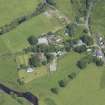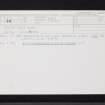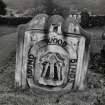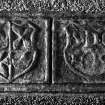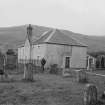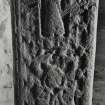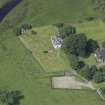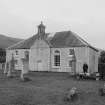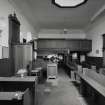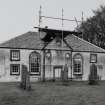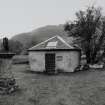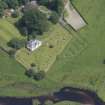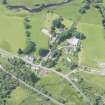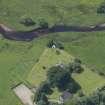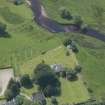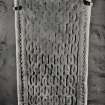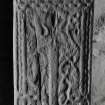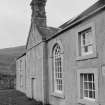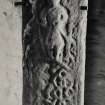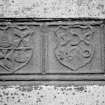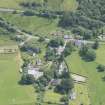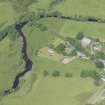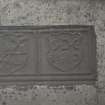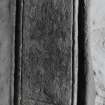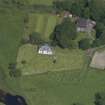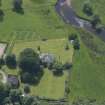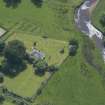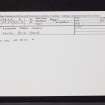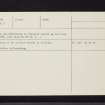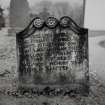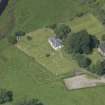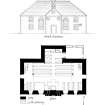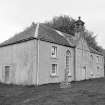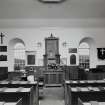Kilmodan Church
Armorial Panel (17th Century), Church (18th Century), War Memorial(S) (20th Century)
Site Name Kilmodan Church
Classification Armorial Panel (17th Century), Church (18th Century), War Memorial(S) (20th Century)
Alternative Name(s) Clachan Of Glendaruel; Glendaruel Estate, Kilmodan Parish Church; St Modan's Church; War Memorial Roll Of Honour; War Memorial
Canmore ID 39962
Site Number NR98SE 5
NGR NR 99512 84184
Datum OSGB36 - NGR
Permalink http://canmore.org.uk/site/39962
- Council Argyll And Bute
- Parish Kilmodan
- Former Region Strathclyde
- Former District Argyll And Bute
- Former County Argyll
NR98SE 5 99512 84184
For Burial Ground see NR98SE 4.00
For Marshall Barr Lapidarium see NR98SE 4.01
(NR 99512 84184) Church (NR) (Site of) (Symbol on 1869 edition only)
OS 6" map, Argyllshire, 2nd ed., (1900)
Kilmodan parish church dedicated to St. Modan, (centred NR 9950 8418) was erected in 1783. Its predecessor, which traditionally was built in 1610, stood to the immediate W, and its materials were used in the building of the present church. A heraldic stone, in the S wall of the present building dated 1610, bears the initials of Sir D Campbell of Auchenbreck, who is said to have built the older church (ONB 1866). There are references to Kilmodan church as far back as 1250. (See also NS08SW 1.)
G Hay 1957; Name Book 1866; M Paterson 1970; H Scott et al 1915-61.
No trace of an earlier church is visible.
No further information.
Visited by OS (D W R) 21 November 1972.
Field Visit (14 September 1942)
This site was included within the RCAHMS Emergency Survey (1942-3), an unpublished rescue project. Site descriptions, organised by county, vary from short notes to lengthy and full descriptions and are available to view online with contemporary sketches and photographs. The original typescripts, manuscripts, notebooks and photographs can also be consulted in the RCAHMS Search Room.
Information from RCAHMS (GFG) 10 December 2014.
Measured Survey (1986)
RCAHMS surveyed Kilmodan Parish Church, Glendaruel in 1986 producing a plan and a south elevation at a scale of 1:100. The survey drawing was redrawn in ink and published at a scale of 1:250 (RCAHMS 1992, 152).
Field Visit (May 1988)
This church is situated in the valley-bottom on the E bank of the River Ruel, S of the 19th-century manse (en.1*) and W of Clachan of Glendaruel. The existing church was built in 1783 to replace an older and more elongated one, possibly of medieval origin, situated on a slightly different alignment and a few metres to the S (en.2*). A site on the hillside 0.8km to the ENE, described in the 19th century as that of St Modan's Chapel, is now identified as the Lephinkill chamberedcairn (en.3*).
The church is of T-plan, measuring 13.5m from E to W by 6.4m within 0.9m walls and having at the centre of the N wall a projection 3.2m deep and 4.1m wide within 0.8m walls. Itis of harled rubble with painted sandstone quoins and dressings, a plain sandstone eaves-course, and a hipped and slated roof. The S front has a slightly projecting centrepiece, 3.8m wide and pedimented above a plain band which is continuous with the eaves-course. It contains a plain blocked doorway and two circular windows with slightly rounded arrises, and in the pediment, which has a moulded cornice, there is a blind roundel. Supported on the pediment is a birdcage belfry with shaped pillars and a stepped roof carrying a ball-finial. The flanking bays contain tall windows with projecting impost-blocks and keystones, and then two tiers of windows lighting the end-galleries. An armorial panel built into the S wall is described infra. Each end-wall has a central doorway with a plain sandstone surround, and each side-wall of the N aisle has a first-floor gallery window. A modern session-room is built in the E re-entrant of the aisle.
The interior retains its original layout, with the galleries of three of the local Campbell families centred on the pulpit set against the S wall. The octagonal pulpit, with tall narrow rectangular panels, may be original, although its pilastered back and pediment are probably of 19th-century date, and there is no sounding-board. The pews, although renewed, are still centred on the pulpit, and there are two long moveable communion-tables. Short flights of stone steps with moulded edges curve to timber stairs giving access to each gallery. The Glendaruel gallery, in the N aisle, has a three-panelled front with a dentillated cornice, while those of the Ormidale and Southhall families, in the W and E ends of the church, are each five-panelled and supported by modern pillars. The interior was lit by a cupola, which was replaced by one of simpler form during a renovation in the early 1980s.
The church serves a parish comprising Glendaruel and the W shore of Loch Riddon. Part of the E shore of the loch is also attached to it, as recommended by the Synod of Argyll in 1642, but adjacent areas remained in Inverchaolain parish despite proposals of 1642 and 1651 (en.4). The dedication was to one of the saints bearing the Irish name Aedan, which here has prefixed the affectionate mo ('my’) (en.5). A chaplain and a rector of Kilmodan are recorded in 1250 and 1299 respectively, and another rector in 1420, but by 1425 the church had become a prebend of the chapter of Argyll, the Crown retaining its existing patronage of the benefice. In the 17th century the revenues are described as being annexed to Whithorn Priory, or the Bishopric of Galloway, but it is not recorded how this came about (en.6).
The armorial stone bearing the initials of Sir Duncan Campbell of Auchenbreck and the date 1610 may indicate a rebuilding or repair of the church at that time, but little is known of the pre-1783 structure. It was said to be ruinous in 1699, and in 1712 there were further complaints about its condition, and those of the adjacent manse and bridge. Anew bell was provided in 1754, but no mention of the rebuilding of 1783 is found in the minutes of the Presbytery of Dunoon (en.7*).
MAUSOLEUM. At the W boundary of the churchyard, in a position indicated on the pre-1783 plan of the glebe, there is a building of har1ed rubble, 3.05m square, having in the E wall a doorway with 80mm chamfer. It is now roofed as a lapidarium, but probably was originally open, and two ball finials of 18th-century type lying beside the doorway may have surmounted the wallhead. This is said to have been a mausoleum of the Campbells of Auchenbreck.
ARMORIAL PANEL. Built into the E end of the S wall oft he church there is a panel of buff sandstone, now painted, measuring 0.69m by 0.38m. An outer moulding frames two panels, each with its own moulded surround: dexter, a shield inscribed SDC / 1610; sinister, a shield quarterly, 1st and 4th a galley; 2nd and 3rd, gyronny of eight. This panel was presumably carved for Sir Duncan Campbell of Auchenbreck, one of the principal heritors in the parish.
RCAHMS 1992, visited May 1988
[see RCAHMS 1992, No. 72 for a detailed description of 21 medieval and post-reformation funerary monuments]
Publication Account (1990)
T-plan church with symmetrical S front, 1783, built a few metres N of medieval building (shown on Ormidale estate-plan). Campbell of Auchenbreck armorial panel, 1610, built into S wall; three galleries, long communion tables and original pulpit. Medieval graveslabs (mainly Loch Awe school) in Lapidarium, and headstones including cooper's tools, 1778, and Gaelic verse epitaph, 1781, in churchyard.
Information from ‘RCAHMS Excursion guide 1990: Commissioners' field excursion, Argyll, 7-9 May 1990’.













































